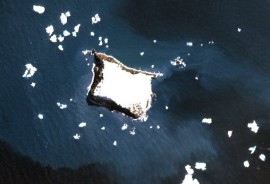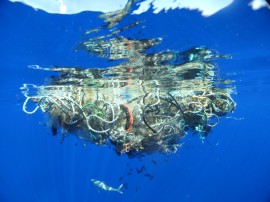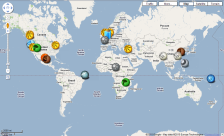Shineanthology’s Weblog
An anthology of optimistic, near future SFOptimistic SF Open Platform
 Welcome to the SHINE anthology website.
Welcome to the SHINE anthology website.
This site is intended to function as an open platform for optimistic SF. Hereby I invite everyone to post ideas, arguments, comments and links on this topic.
Optimistic SF is like the future: a work in progress.
Guidelines for the SHINE anthology can be found in the sidebar, under the “GUIDELINES” category.
There will be semi-regular posts about topics that touch optimism, near-future and SF. Those will, hopefully, prime your imagination.
As a starting point (not *the* starting point, but one of more to come) I´m posting a part of the official SHINE press release below:
SHINE is a collection of near-future, optimistic SF stories where some of the genres brightest stars and some of its most exciting new talents portray the possible roads to a better tomorrow. Definitely not a plethora of Pollyannas (but neither a barrage of dystopias), SHINE will show that positive change is far from being a foregone conclusion, but needs to be hardfought, innovative, robust and imaginative. Most importantly, it aims to demonstrate that while times are tough and outcomes are uncertain, we can still bend the future in benevolent ways if we embrace change and steer its momentum in the right direction. Let´s put the ´can´ back in “We can do it”, and make our tomorrows SHINE.
Feel free to bombard me with questions and comments!
UPDATE: I replaced the placeholder picture with the actual Shine artwork. The artist is Vincent Chong, and originally I commissioned this from him for promotional purposes (people who attended either Anticipation in Montréal or World Fantasy in San José may have gotten hold of a flyer featuring it). We worked on this together, that is Vinny doing the utmost majority of the job: trying to produce what I had in mind. I think he succeeded spectacularly. It’s also featured on Vincent’s gallery here.
When the new Solaris Books editor, Jon Oliver, contacted me about artwork, I told him about the Vincent Chong piece I already commissioned (albeit that I only had limited rights to it), and he liked it so much that it has become the actual cover artwork.
And here the picture placeholder for sentimental value:
Awards Pimpage: SHINE stories + Three Real-Life Links
Since several award nomination time slots just opened, I will list the Shine stories that are eligible (well, all of them except “Summer Ice” which is a reprint), with their word count.
Short stories (less than 7500 words):
- The Greenman Watches the Black Bar Go Up, Up, Up — Jacques Barcia: 7000 words (excerpt);
- Sustainabe Development — Paula R. Stiles: 1000 words (excerpt);
- The Solnet Ascendancy — Lavie Tidhar: 3400 words (excerpt) + (podcast);
- Twittering the Stars — Marie Ness: 6400 words (excerpt);
- Seeds — Silvia Moreno-Garcia: 1700 words (excerpt) + (full story @ HUB);
- Scheherazade Cast in Starlight — Jason Andrew: 1000 words (excerpt);
- Castoff World — Kay Kenyon: 5200 words (excerpt) + (podcast) + (full story @ io9);
- Paul Kishosha’s Children — Kenn Edgett: 7000 words (excerpt);
Novelettes (7500 – 17500 words):
- The Earth of Yunhe — Eric Gregory: 8000 words (excerpt) + (podcast);
- Overhead — Jason Stoddard: 9800 words (excerpt);
- The Church of Accelerated Redemption — Gareth L. Powell & Aliette de Bodard: 10,000 words (excerpt);
- At Budokan — Alastair Reynolds: 8200 words (excerpt);
- Sarging Rasmussen: A Report by Organic — Gord Sellar: 10,000 words (excerpt) + (podcast @ StarShipSofa);
- Russian Roulette 2020 — Eva Maria Chapman: 10,000 words (excerpt);
- Ishin — Madeline Ashby: 9000 words (excerpt);
Excerpts of every story + four podcasts + two full stories online. If I give away anything more, the publisher will strangle me…;-)
Thanks everybody for your consideration.
Now, to spice things up a little. I came across three real-life events — sometimes via/via — that do have links to a few Shine stories.
First, via an article in the Guardian about how ‘green’ the UK’s coalition government (who promised to be “the greenest government ever”) actually is, I came upon this documentary: “The World According to Monsanto“, about the power politics of this huge GM company. It reminded me immediately of the fictional company Germingen in Silvia Moreno-Garcia’s “Seeds“.
Second, a Facebook post of (someone whose name escapes me: my apologies!) linked to an article on the New York Times’ Opinionator: “To Beat Back Poverty, Pay the Poor“. Indeed, successful government programs for that are running in Mexico (where “Seeds” is set) and in Brazil: which immediately brought the opening section of Jacques Barcia’s “The Greenman Watches the Black Bar Go Up, Up, Up” (which takes place in a Brazil that is much less poor).
Third, directly from the Guardian: “Nigeria: the Happiest People on Earth“. Counterintuitive, right? With all this trouble in the Niger delta where Shell is exploring oil? The country of the same-titled internet scams? And immense poverty?
Well, read the article: it’s not only doom and gloom, and these people are trying to change things for the better. And they keep a positive outlook throughout, just like the women in Paula R. Stiles’ “Sustainable Development“. In the Gallup Poll “Global Barometer of Hope and Despair for 2011” (opens PDF: the ‘Net Hope’ scores are on page 61) Nigeria ranks highest, with a score of 70. Vietnam (61) and Brazil and Ghana (both 47) are numbers two and three. France ranks as the most desperate: a negative score of -58, followed by Iceland (-51), Romania (-47) and the UK (-44).
If anything, that poll demonstrates that money doesn’t (necessarily) make you happy.
UPDATE 1: via John Shirley (on Facebook) I was pointed to this MSNBC article: “US Building a Network to Hit Militants“, about the use of drones. A few quotes:
Its targeting advice will largely direct elite special operations forces in both commando raids and drone missile strikes overseas.
Several military intelligence officials said the center is the brainchild of JSOC’s current commander, Vice Adm. Bill McRaven, who patterned it on the success of a military system called “counter-network,” which uses drone, satellite and human intelligence to drive operations on the ground in Iraq and Afghanistan, according to a senior U.S. official reached Wednesday.
Which immediately reminded me of Madeline Ashby’s “Ishin“, in which a more positive application of the same technology is explored. Picture of the Predator Drone courtesy of the Support Daniel Boyd’s Blog, which has this choice quote:
The “pilots” say that the greatest problem is stress from “detachment.”
Which is exactly what one of Ishin‘s protagonists — Brandon — is suffering from. Hell of a well-researched and finely wrought story, that becomes more relevant by the day.
UPDATE 2: via de Volkskrant, I found “Young Children Share the Spoils” on Psychological Science. This research seems to suggest that sharing is innate. So I couldn’t help but think of Holly Phillips’s “Summer Ice“, where Manon shares a lot with the new community she’s moved into, and it pays back (with dividends).
Intimations of Immortality: Are We Ready for Extreme Longevity, or Do We Even Deserve It?
Although this is a rather belated nusing about a panel topic in this year’s AussieCon IV in Melbourne, I think the topic is sturdy enough to stand the test of time (Q.E.D.).
Let’s start with William Wordsworth:
The panel at AussieCon IV was “Implications of Immortality”, and the panel description was:
Immortality is a common element in science fiction and fantasy, but what would it actually be like?
What would you need to do and think about if you were immortal? How would society need to change if we were all immortal?
In a world where we are no longer faced with an end to our lives, how would human society change?
In general, I was rather disappointed by this panel (audio transcript here, courtesy of the Singularity Institute for Artificial Intelligence), as it mostly repeated SF and fantasy’s clichés about immortality, and didn’t really reach any interesting, new (let alone ground-breaking) conclusions.
So, with this panel, and a number of internet articles about immortality — Annalee Newitz on io9 (Four Arguments against Immortality), Jason Stoddard (Four Arguments FOR Immortality), BBC’s recent Do You Really Want to Live Forever?, an interview on I Look Forward To about the possibility of immortality or extreme longevity with Aubrey de Grey and David Brin (When Will Life Expectancy Reach 200 Years?), Edward Cheever’s In Defense of Immortality — in mind, I’m going to try to deconstruct a number of faulty assumption about extreme longevity.
You may have noticed that I’m not calling it ‘immortality’ anymore. Well, I think immortality is in the same class as Utopia, infinity and perfection: a great destination to travel to, but one that can never be reached. Yet we should try, nevertheless. While immortality is an unreachable ideal, the effort of reaching it will bring huge progress and immense advantages. So let’s be a tad more realistic and call it the quest for longevity, or extreme longevity.
Problem is, a lot of people think we shouldn’t be on this quest anyway, because of several misconceptions. Let’s go through them:
(1): Humans are not ‘wired’ for immortality or extreme longevity.
As (panel member) Will McIntosh said (I’m paraphrasing here): “the human psyche is not wired for immortality: in almost every thing we do lies the shadow of our oncoming demise.” However, this assumes that humans will not change. I think humans will change. Actually, humans are already changing, and have been changing throughout history.
The problem with a lot of thinking in science fiction is that it often takes one — and only one — idea and tries to imagine its impact on humans and/or society while assuming that the latter (humans and society) do not change, or only minimally through that one single idea. In reality, though, society is an immensely complex web of connections that all influence each other.
Therefore, as such, both humans and society have changed over the years, also (among many other things) in regards to life expectancy. Life expectancy has increased (and is still increasing), and we have learned to live with that. Less than two centuries ago we would become, on average, 37 years old. Our ‘productive’ life span was 20 to 25 years. Now we get, on average, 77 years old, with a ‘productive’ life span of over 40 years.
Indeed: right now we have more ‘productive’ years than we actually lived 200 years ago. And if someone had said, back in 1810, that humans aren’t wired to live 80 years, most people would have agreed.
Well, immortality won’t happen overnight: it will take time to develop much longer lifespans, followed by extreme longevity. Time enough for humans to change, and to adapt successfully to a much longer life. People have been changing all the time — albeit at a much higher rate in the past 100 years — and have been able to cope. Why shouldn’t we be able to do so in the future?
Imagine someone in 1810 saying that in 200 years people would travel around the world regularly, that we would live twice as long, and that we would be able to talk to people at the other side of the globe through a device that weighs less than a book. Now imagine depriving your 8-year-old kid from her/his gameboy, cell phone, or internet connection.
I’ve been discussing this with (Guest of Honour) Kim Stanley Robinson at the bar right after the panel, and he thought that such thinking — humans will remain the same while the world around them changes — is ‘a failure of the imagination’. I agree: by the time extreme longevity is possible, we will have developed the right mindset for it.
However — as Annalee Newitz proposed on io9 — we may change so much that we’re no longer human. Well, try to define ‘being human’ first. Then compare that 21st Century definition with that of a 19th Century one: there will be quite a number of differences. As mentioned, humans change, and the yardstick that ‘defines’ humanity changes, as well.
Of course, Annalee voiced the fear that we might become emotionless monsters as we develop extreme longevity. I disagree: there have been monsterous humans throughout history, Stalin, Hitler and Pol Pot just a recent addition to a long, long list that stretches back to the dawn of human memory. Yet we have always overcome these monsters: why shouldn’t we be able to do that in the future?
I’ll even go a step further: it makes much more sense to be a ruthless dictator and burn all your bridges behind you if your lifespan is short. Conversely, if you realise that you have several centuries to go, it makes little sense to rampage an ecology that you need to support your much longer life. Even beter, as longer lifespans (or even extreme longevity) spread throughout the world population (and it will: see point 3 of this post), then it is in everybody’s best interest to weed out those so hell-bent on power that they are willing to destroy a very long term infrastructure (like say, Gaia) for it.
(Not to mention the non-starter ‘Whatever body you’re in, there you are‘. Sorry: last time I looked all of us are constrained to one, and one body only. I personally will highly appreciate it if it lasts much, much longer.)
(2): Immortality is boring: I will be stuck with the same dead-end job/uninteresting life/pointless existence forever.
As mentioned, immortality is an idealised concept: it is an endpoint that we might approach asymptotically, hence it will not happen overnight. Still, quite a few people (some of which were in the audience of the panel) seem to think so. One even literally mentioned that ‘immortality would be a kind of eternal hell as she would be stuck with the same dead-end job forever’.
In the grander scheme of things, holding a steady job throughout one’s carreer may already be a passing fad in times to come. Yes, in times of yore one — before the 20th Century almost always a man — acquired (either through education, experience, inheritance or a combination thereof) a job or profession and stuck to it for the rest of one’s productive life. Exceptions acknowleged, of course, but those were few and far in between.
But nowadays, things are different, completely different, just check out this video: “Shift Happens: Bringing Education into the 21st Century”
A few price quotes:
—1 out of 4 workers today is working for a company they have been employed by for less than one year
—More than 1 out of 2 are working for a company they have worked for for less than five years
…the top 10 in demand jobs for 2010 did not exist in 2004
—We are currently preparing students for jobs that don’t yet exist…
…using technologies that haven’t been invented…
…in order to solve problems we don’t even know are problems yet
Basically, the amount of jobs that you can hold for your complete productive life is shrinking: a ‘job-for-life’ is increasingly becoming a feature of the past.
Therefore, in order to keep making a living people already need to keep educating themselves, constantly. I know what I’m talking about: I train people in my company’s product, and I need to stay updated. I teach and I learn, all the time.
Some people see this as a bad thing: such people like to keep on doing the same things, ad nauseam until their pension. This, though, is increasingly not an option anymore.
I see this as an interesting, and potentially good development: now people (must) keep developing themselves, learning new things, broadening their horizons, expanding both the depth and the breadth of their knowledge.
Isn’t this an exhilarating convergence? As life expectancy grows, life is becoming more interesting, as well. Maybe we are already on the right track to leading longer and more fullfilling lives by being able to change constantly?
Now before some of you — like Athena Andreadis (see point 2) — start to argue that the memory and learning capacity of a human brain is limited, let me make a bet (for a drink, or a symbolic amount like one Euro): I bet that before people live so long that their brain capacity is insufficient to store, work or even understand all the knowledge they build up in their extended lifetime, that there will be not one, but a variety of competing options to extend that brain capacity. For example, check out Andy Clark’s article “Out of Our Brains” in the New York Times (via Futurismic).
(3): Only the superrich will have immortality, and will keep it ‘locked away’ from the rest of the world.
Or point 4 (“We’ll have to deal with the immortality divide“) of Annalee Newitz’s io9 post.
This argument assumes that:
- there is an immediate development that changes life expectancy immensely;
- that this — nearly instantaneous — development is so expensive that only the superrich can afford it;
- that the superrich elite will be able to keep this development completely to themselves;
Personally, I suspect it’s extremely unlikely that a ‘silver bullet’ for highly increased longevity (let alone extreme longevity and forget about immortality) will be developed overnight. It’s hugely more likely that longevity will increase in leaps and bounds, with all kinds of dead alleys, red herrings and fool’s gold (to deftly mix metaphors) along the way. The way almost all scientific research does. The way longevity has been increasing already.
So while I do expect that there will be new treatments that lengthen lifespan, I do, very strongly, suspect that these will not stay with the ultra-healthy among us for long.
Consider: there are about a thousand billionaires in the world right now. There are about 10 million millionaires. By 2030, about two billion new people may join the world middle class (via Goldman Sachs: opens PDF file): adding this to the 1.5 billion middle class people as of 2010, this will total 3.5 billion middle class incomes.
So a big pharmaceutical company would keep its product exclusive to the happy thousand? Even after it has earned back its development costs? And will ignore the 10 million plus other, rich customers? And once the treatment has been proven to work for over a million people, they will not eventually want to sell it to almost 4 billion more customers? That’s not how capitalism works, last time I looked.
Then there is the case of the ghost having escaped the bottle: in science, once something has been proven to be possible, it can be replicated. If an experiment can’t be verifiably repeated, it’s not true science. So if it’s possible (extreme longevity, even immortality) then competing scientists will know that, and they will redouble their efforts to reproduce the same result.
Once a certain development’s time has come, it shows up everywhere. Tesla’s and Marconi’s dispute about who invented radio first is one example. The rise of aviation (once the Wright brothers delivered proof of concept) is another. There are countless more. And these technologies, once new, are now available to almost everybody: radio (is become obsolete by the internet, another technology initially developed for the hapy few — the Pentagon or CERN— available to all), avaition, the utmost majority of modern medicine. Once the cat is out of the bag…
Competition, the desire to sell it to as much markets as possible, the fact that it can be done all will make sure that it eventually becomes available to all. Inevitably.
(4): (a) Biological immortality or biological extreme longevity is impossible; and (b): mind uploading is a pipe dream.
Check out this interview with Aubrey de Grey and David Brin: When Will Life Expectancy Reach 200 Years?
The above gentlemen are talking about a life expectancy of 200 years. While that may sound already unrealistic to some, and a bit unambitious to others (what is 200 years in the face of extreme longevity?), there is a tipping point. As Ronald Bailey explains in his Liberation Biology:
“Researcher reported in the April 2002 issue of Science that life expectancy has been increasing at about two and a half year per decade for the past 160 years. Demographers such as Olshansky, they note, have been consistently wrong in predicting an upper limit to this trend. In 1928, for example, demographer Louis Dublin predicted that average life expectancy in the United States would never exceed 64.75 years. Today it is 77.6 years.”
“At this rate of improvement, the authors of the Science report conclude that “record [average] life expectancy will reach about 100 in six decades”.”
It gets better:
De Grey offers a scenario in which efforts to achieve radical life extension reach “actuarial escape velocit (AEV)”. Recall that for the last 160 years, average life expectancy has increased by two-and-a-half year per decade. What if increases in life expectancy rose at a rate of ten years or more per decade? “The escape velocity cusp is closer than you might guess,” claims de Grey. “Since we are already so long lived, even a thirty percent increase in healthy life span will give the first beneficiaries of rejuvenation therapies another twenty years—an eternity in science—to benefit from second generation therapies that could give another thirty percent, and so on ad infinitum”
Yes, the same Aubrey De Grey interviewed above. The above quote can be found online on PLoS Biology: ‘Escape Velocity: Why the Prospect of Extreme Human Life Extension Matters Now‘.
Extreme longevity in this century? Maybe even in our lifetime?
As noted above, David Brin disagrees, as I’m sure many of you do. “There are way too many obstacles,” I hear you say, “there is no low-hanging fruit.” Further cue to David Brin:
All advances to date have involved allowing ever-greater percentages of humanity to hit the “wall” at age 100, and maybe coast a few years beyond. Getting beyond that will require either;
1) THOROUGH nanotechnology, applied down at the INTRA-cellular level, or
2) genetic recoding to enhance repair capabilities in new ways (good news for our great grandchildren, maybe), or
3) gradual replacement of failing parts and systems with prosthetics, or
4) uploading.Oh, I am willing to be proved wrong, but all of these seem much harder than the zealots think.
a) The intra-cellular world is the next frontier. It now seems huge, complex, involving massive amounts of computing. Will you flood the INSIDES of cells with nanomachines? Good luck.
b) We haven’t a clue how to do #2.
c) #3 will happen in phases. But when the brain fades… well,… see #a
c) re #4 — see #a
(Emphasis mine.)
The Aubrey De Grey/David Brin interview was posted on November 25, 2010. Three days later, this news came out: “Harvard Scientists Reverse the Ageing Process in Mice“. Price quote:
The Harvard group focused on a process called telomere shortening. Most cells in the body contain 23 pairs of chromosomes, which carry our DNA. At the ends of each chromosome is a protective cap called a telomere. Each time a cell divides, the telomeres are snipped shorter, until eventually they stop working and the cell dies or goes into a suspended state called “senescence”. The process is behind much of the wear and tear associated with ageing.
At Harvard, they bred genetically manipulated mice that lacked an enzyme called telomerase that stops telomeres getting shorter. Without the enzyme, the mice aged prematurely and suffered ailments, including a poor sense of smell, smaller brain size, infertility and damaged intestines and spleens. But when DePinho gave the mice injections to reactivate the enzyme, it repaired the damaged tissues and reversed the signs of ageing.
This sounds very much like ‘genetic recoding to enhance repair capabilities in new ways’. And yes, it is only applicable to mice (“Repeating the trick with humans will be more difficult”), and developing a method that works for humans might still be a long way off. Yet, we have gone from “We haven’t a clue how to do #2” to “We have found a method that works in mice”.
So while extreme longevity is probably not around the corner, I believe that it is possible. At the very least we can expect that our life span will continue to increase in the future, as it has done for the past 160 years. Very probably with more than 2-and-a-half year per decade. I strongly suspect that auctuarial escape velocity will not be a matter of if, but of when.
And then extreme longevity is a fact of life.
Finally, as to (b): mind uploading is a pipe dream;
I don’t know.
On the one side, the human brain is an immensely complex organ, of which we still understand very little (even though our knowledge is increasing). It’s also very unclear if a mind based so intimately in a biological body can be ‘transported’ or ‘copied’ to a non-biological mainframe, without considerable losses in either functionality or memory or both.
On the other side, if Moore’s Law holds (and it’s not showing any signs of slacking up yet), then by the time mind uploading is possible — even when it happens only a few decades from now — then there will be a hell of a lot of computing power available to upload into.
Apart from that, if uploading becomes possible, there is still the problem that, in all likeliness, it will be copying your mind into a different substrate, leaving the original behind to die. That’s why I prefer developments of extending lifespan of our biological bodies: it seems the better bet.
Picture credits:
- Blue Trefoil Knot: via Wikipedia;
- Shift Happens: via Shifting Paradigms;
- Intimations: via Photography Blog;
- Intimations of Immortality: via The Millstone;
- Actuarial Escape Velocity: from the PLoS Biology article;
- Golden Trefoil Sculpture: via Into the Deep;
Utopia: A Vindication?
As the second comment (by Paul Graham Raven) already noticed, maybe I could see Charlie Stross’s post about Utopia as a kind of vindication?
 [Picture: Vindication Island: a destination, never to be reached, like Utopia?]
[Picture: Vindication Island: a destination, never to be reached, like Utopia?]
For one, science fiction in general is—again, see the huge catch-up exercise called cyberpunk ( the punk label itself was already a few years outdated back in 1983, which indicates how pathetic the ‘punk’ label sounds in steampunk, dieselpunk, mythpunk and what-have-you-punk. Where is SF’s imaginative use of neologisms when you really need it?) when SF belatedly realised it had been neglecting these dang computers for too long—behind the curve: see, for example, last year’s four-issue special called Blueprint for a Better World that New Scientist featured from September 12 until October 3 in 2009.
In other words—and I have already voiced this almost ad nauseam here on this blog—while SF wallows in its dystopias, gloom’n’doom scenarios and total apocalypses, people in (gasp) the real world are already looking for solutions to our problems.
I am already tired of SF fandom’s idea that science fiction should inspire science, or the real world. It has been the other way around, mostly, and increasingly overwhelmingly in the past few decades.
What use does an African boy have for apocalyptic science fiction if he wants to build to a better future? Why would people in rural Bangladesh need to read the latest eco-disaster if they are visited by the InfoLadies instead? People in the real world aren’t longing for depictions of dystopia to show them how it shouldn’t be done: they’re way too busy to improve their own lot.
So, in the larger scheme of things, it’s probably a minor vindication for an idea—optimistic SF, *not* Utopia—whose idea seems finally, and belatedly to be entering the SF writing community’s mindset.
{BTW: not Utopia. the term ‘Utopia’ alone is a button-pusher in the science fiction crowd, immediately unleashing the all-too-predictable clichés: “Utopias are booooooooring”, “There can be no conflict in Utopian stories” (hence, when I demonstrate that conflicts are part and parcel of a near-future, optimistic SF story—one needs to overcome big hurdles to achieve improvements—Kathryn Cramer laments that ‘SHINE delivers (mostly) happy endings in dystopias rather than actual utopian speculation‘: true, as I never intended SHINE to be a plethora of Pollyannas), “Dystopias are the signs of the future saying ‘do not go there’.” (so in which direction should we go? We only need negative incentives?), “One man’s Utopia is another man’s Dystopia”, Etcetera, ad nauseam.}
For another, this review gives me much more vindication:
Anyway, just about a textbook example of how to do it […]
I thought this book would be decent – so when it hits around the excellent mark and is a great price currently you really should buy it.
Having read hundreds of anthologies it isn’t often that I want to revisit one soon afterwards, Shine is definitely one such.
Finally, an editorial remark. To quote Blue Tyson from the above-mentioned review:
Interestingly, he says most of the writers around are pathetically incapable of writing a story along these lines – which is odd, given as they say, ideas are a dime a dozen.
Unfortunately, this is true. I have sollicited many, very many of today’s well-known SF writers for Shine, and the utmost majority of them wouldn’t or couldn’t (or shouldn’t?) produce a near-future, optimistic SF story. One in particular—whose name shall remain unknown—telling me that ‘near-future SF is mind-numbingly hard these days’.
So there you go: is near-future, optimistic SF too hard to do, or are contemporary SF writers suffering from—and here I’m quoting another well-known SF author, with whom I discussed this at a recent WorldCon—”a failure of the imagination”?
To be continued, I hope…
SHINE excerpts: “Twittering the Stars”
While most story excerpts from the Shine anthology have appeared already at DayBreak Magazine, I decided to post them here, as well (after all, this *is* the Shine website). This is the eighth one: “Twittering the Stars” by Mari Ness:
Note 1: Indeed, it’s a story told completely in tweets, and like the Twitter website, the most recent tweets show up on top. Yet, “Twittering the Stars” is written in such a way that you can read it in either direction (from top to bottom or vice-versa) and it still works beautifully.
Note 2: Our current astonauts are already using Twitter, sending twitpics from the International Space Station (via BoingBoing; via io9) from astronauts Jose Hernandez (@Astro_Jose) and Souichi Noguchi (@Astr_Soichi), who are both on Twitter. Simply breathtaking, indeed!
Note 3: when I was thinking about a name for the online magazine accompanying the Shine anthology, ‘Dawn’ immediately came to mind, but eventually I figured ‘DayBreak’ worked a bit better. I wasn’t aware of the ‘Dawn’ spacecraft concept — pictured below the excerpt — that NASA was (is?) developing for solar system exploration.
@the28thkarenbear Well, being the sweetest out of 6 doesn’t mean much.
6:54 pm March 13th, 2052 from distweet in reply to the28thkarenbear
@the28thkarenbear AWW. You are the sweetest person on the planet.
5:23 pm March 11th, 2052 from distweet in reply to the28thkarenbear
I probably could concoct some alcoholic thing from my plants, but probably not the best idea.
1:19 pm March 10th, 2052 from distweet
Still, if you’re reading this, please respond. Just so that I don’t feel so alone.
10:42 am March 8th, 2052 from distweet
Right. Keep forgetting that it now takes hours for my tweets to reach you and hours for you to respond.
10:42 am March 8th, 2052 from distweet
Is anybody reading this? Anybody?
7:18 pm March 7th, 2052 from distweet
I wish all of you could see this with me.
3:01 am February 26th, 2052 from distweet
Slightly upsetting to realize that a supernova is much brighter than Earth, but it’s so beautiful.
5:18 pm February 23rd, 2052 from distweet
We’re watching the Betelgeuse supernova too. It’s—I can’t tell you how spectacular it is from here. Only the sun is brighter.
5:16 pm February 23rd, 2052 from distweet
To make up for it, A had pictures of little red envelopes on our hand screens, that exploded into fireworks when we thumbed over them.
8:03 pm January 23rd, 2052 from distweet
A celebrated Chinese New Year today by opening every door on the ship. I think she just wanted to catch T naked.
8:02 pm January 23rd, 2052 from distweet
Sorry for the long silence. Just finding that I don’t have much to say. I’m caught in the silence of stars.
4:02 pm October 12th, 2051 from distweet
@frogheart29 My first niece! Congratulations! I wish I could hold her. Show her pictures of me for me, will ya?
7:43 pm May 17th, 2051 from distweet in reply to frogheart29
And when the plants are growing, they’re growing in weird directions.
12:49 pm May 5th, 2051
@loucheroo Oh, we’re fine for food even without the garden. I just miss biting into a real tomato, you know?
12:42 pm May 5th, 2051 from distweet
I think the plants know we’re leaving the sun.
10:31 am May 4th, 2051 from distweet
The garden isn’t producing as much as expected. We should have everything—real soil, water, fertilizer, robot pollinators—
10:31 am May 4th, 2051 from distweet
I keep finding myself looking out the portholes in the gardens and labs and in our living area, and wanting to sing to the stars.
6:02 pm April 23rd, 2051 from distweet
Trying to figure out how K passed the psych tests to get on here. I know, double PhD, quan comp/eng, 8 years Chinese Air Force. Still.
3:22 am March 27th, 2051 from distweet
Ok, our worst mistake? Letting R bring along his horror film collection. In space no one can hear you scream. Yeah, right.
4:06 am March 7th, 2051 from distweet
I say I keep everyone breathing.
10:13 pm February 26th, 2051 from distweet
T says he keeps everyone alive. Not that anyone’s needed a doctor yet, and we haven’t seen him do anything else except watch the stars.
10:12 pm February 26th, 2051 from distweet
A says she’s the only one with mission for the entire trip. The rest of us stop after we mine the iridium/lithium.
10:12 pm February 26th, 2051 from distweet
K and R say they are piloting the ship. Without them, no iridium/lithium.
10:11 pm February 26th, 2051 from distweet
Major fight broke out over who has the most important job on the ship. M says lithium entire point of trip.
10:11 pm February 26th, 2051 from distweet
Sigh. SOME people have no idea how to share living quarters. You’d think a doctor of all people would be less of a slob.
8:11 pm January 24th, 2051 from distweet
 Excerpt from “Twittering the Stars” by Mari Ness. Copyright © 2010 by Mari Ness.
Excerpt from “Twittering the Stars” by Mari Ness. Copyright © 2010 by Mari Ness.
Picture credits:
- Earth & Moon picture: astronaut Jose Hernandez of the ISS;
- Supernova: via Grant Chronicles;
- Dawn Spacecraft: via Wikimedia Commons;
 Mari Ness lives in central Florida, and likes to watch space shuttles and rockets leap into the sky. Her work has previously appeared in numerous print and online venues, including Fantasy Magazine, Hub Fiction and Farrago’s Wainscot. She’s still hoping to spend time in a space station some day.
Mari Ness lives in central Florida, and likes to watch space shuttles and rockets leap into the sky. Her work has previously appeared in numerous print and online venues, including Fantasy Magazine, Hub Fiction and Farrago’s Wainscot. She’s still hoping to spend time in a space station some day.
Also, check out the exclusive interview Charles A. Tan with her at SF Signal.
Review Quotes:
I started reading the story from the beginning… then realised that it’s written in the present and what I really should do is start at the end of the story and read forward! Make sense? (It will if you tweet yourself) And I loved it. Cleverly constructed, the author manages to tell a heartbreaking story across the time period of four years. We see the main character go from an over-excited and slightly egotistical botanist going on a space mission to a deeply thoughtful, sad and very humane being. A very clever piece of writing and one I’d recommend.
—SF Revu;
One of the most original stories I’ve read in years is Twittering the Stars by Mari Ness, which is constructed entirely of tweets (messages of 140 characters or less) and tells the story of a deep space crew mining lithium and iridium – and a discovery that will change them all forever.
—Explorations: the Barnes & Noble SciFi and Fantasy Blog;
and my personal favourite, Twittering the Stars by Mari Ness: an account of a space expedition, told as a series of tweets.
Twittering the Stars really made me think about how we tell our stories.
In the case of Mari Ness’ Twittering the Stars, the literary constraint is structural. What could have been little more than a gimmicky format (the clue is in the name) is used to break a tale of unlucky asteroid miners into pithy, revealing chunks that comprise a grippingly personal narrative.
Mari Ness offers a formally challenging tale of an astronaut gardener’s tweets, and the messages are even presented in reverse chronological order, which makes for an evocative experience. “Discussion over what to do with T’s body” is just one of many powerful lines, but the story is hurt by an uninspired little fart of a title: Twittering in Space.
(Editor’s note: actual title is Twittering the Stars.)
Twittering the Stars by Mari Ness could be interpreted as gimmicky due to its use of the Twitter format but Ness makes the most out of her medium. The story immediately engulfs you in the drama and wins you over to the protagonist’s side. What’s deceptive about the piece is that it’s quite lengthy but because Ness uses Tweets, it doesn’t feel overbearing. Another bonus is that the story could be read in reverse order and would still be just as relevant.
A second story I want to mention is Twittering the Stars by Mari Ness. De Vries is apparently a big fan Twitter. He mentions the medium a number of times in the introductions to the various stories. I’m not a great fan my self, I will sacrifice knowing things now to knowing them in a bit more detail at a time of my own choosing but you can’t deny it’s popularity. Ness wrote a story that is completely conveyed in the form of Tweets and starts with the newest message at the top. The story is that of a space ship returning to earth after visiting the asteroid belt. Clearly something has going wrong en route and we gradually work our way back to the point where we find out what. This story can be read in the reverse order as well and that makes it pretty unusual. It’s a very interesting and quite succesfull experiment in using such a new medium for literary purposes.
The one story I disliked immensely for its twitter format; for me this kind of short paragraphs interspersed with the twitter paraphernalia is annoying in the extreme; otherwise the content seemed interesting enough with a space expedition and some biology experiments, but I just hate fiction formatted like that…
An interactive map of SHINE anthology story locations:
SHINE podcast: ” Castoff World”
As some of you may have noticed through io9, here is the wonderfully narrated podcast—by the phenomenal Kate Baker—of Kay Kenyon’s “Castoff World”.
Podcast:
Enjoy!
Picture credits:
- Dead Bird Plastic : via Naked Man in the Tree;
- Garbage Patch: via Lindsay Hoshaw;
 Kay Kenyon’s latest work, published by Pyr, is a sci-fantasy quartet beginning with Bright of the Sky, a story that introduced readers to the Entire, a tunnel universe next door. Publishers Weekly listed this novel among the top 150 books of 2007. The series has twice been shortlisted for the American Library Association Reading List awards. The final volume, Prince of Storms will appear in January 2010. Her work has been nominated for major awards in the field and translated into French, Russian, Spanish, Czech and audio versions. Recent short stories appeared in Fast Forward 2 and The Solaris Book of New Science Fiction, Volume Two. She lives in eastern Washington state with her husband. She is the chair of a writing conference, Write on the River, and is currently working on a fantasy novel. All of her work has happy endings, except for those with characters who, alas, must die.
Kay Kenyon’s latest work, published by Pyr, is a sci-fantasy quartet beginning with Bright of the Sky, a story that introduced readers to the Entire, a tunnel universe next door. Publishers Weekly listed this novel among the top 150 books of 2007. The series has twice been shortlisted for the American Library Association Reading List awards. The final volume, Prince of Storms will appear in January 2010. Her work has been nominated for major awards in the field and translated into French, Russian, Spanish, Czech and audio versions. Recent short stories appeared in Fast Forward 2 and The Solaris Book of New Science Fiction, Volume Two. She lives in eastern Washington state with her husband. She is the chair of a writing conference, Write on the River, and is currently working on a fantasy novel. All of her work has happy endings, except for those with characters who, alas, must die.
Also, check out the exclusive interview Charles A. Tan did with her at SF Signal.
Review Quotes:
Kay Kenyon’s fantastic Castoff World chronicles the life of Child, a young girl whose entire existence has been spent on a garbage island adrift in the ocean. Her only companionship is a sickly grandfather and something she calls Nora — a Nanobotic Oceanic Refuse Accumulator that has continued its mission of collecting pollutants from the water, breaking them down, and transforming them into “good stuff.”
—Explorations: the Barnes & Noble SciFi and Fantasy Blog;
Likewise the events of the touching Castoff World by Kay Kenyon are restricted to a tiny stage — a makeshift Pacific raft — that nonetheless serves as an effective microcosm of broader ecological concerns.
Kay Kenyon’s wonderful story Castoff World of a young girl’s life aboard a floating reclamation centre;
Castoff World by Kay Kenyon has an amazing dreamlike feel to it. It’s about a girl, her Grappa (older grandfather figure) and a boat called Nora drifting on the ocean. It’s about truth and having to fend for yourself. It’s a bit Big Blue in its feel and the ending made me well up and sigh that Child will now no longer be alone. Beautiful.
—SF Revu;
The last story I want to mention is Kay Kenyon’s Castoff World. The story is about Child and her Grappa floating around on a barge originally intended to clean up the Ocean of pollutants like plastics. The barge has long since lost contact with the people who designed and ran it and it is now floating freely on a dangerous ocean, collecting ever more rubbish. We see the story from Child’s perspective. It’s a very touching story, I particularly liked the subtle presence of artificial intelligence. Beautifully written. This one is probably my favourite in the entire collection.
A story about the “friendship” between the orphan Child and Nora, a “Nanobotic Oceanic Refuse Accumulator” aka “an ocean garbage eating artificial island” which is Child’s only known home. While a bit too short, this story hearkens back to the traditional lost in the world adventure and it’s wonderful.
An interactive Google Map of story locations from the SHINE anthology:
SHINE Podcast: “The Solnet Ascendancy”
As promised in the previous post, here’s a podcast of Lavie Tidhar‘s “The Solnet Ascendancy“, narrated, very vividly, by Ray Sizemore.
Enjoy!
 Lavie Tidhar is the author of linked-story collection HebrewPunk (2007), novellas Cloud Permutations (2009), An Occupation of Angels (2010), and Gorel & The Pot-Bellied God (2010) and, with Nir Yaniv, of The Tel Aviv Dossier (2009). He also edited the anthology The Apex Book of World SF (2009). He’s lived on three continents and one island-nation, and currently lives in Israel. His first novel, The Bookman, is published by HarperCollins’ new Angry Robot imprint, and will be followed by two more.
Lavie Tidhar is the author of linked-story collection HebrewPunk (2007), novellas Cloud Permutations (2009), An Occupation of Angels (2010), and Gorel & The Pot-Bellied God (2010) and, with Nir Yaniv, of The Tel Aviv Dossier (2009). He also edited the anthology The Apex Book of World SF (2009). He’s lived on three continents and one island-nation, and currently lives in Israel. His first novel, The Bookman, is published by HarperCollins’ new Angry Robot imprint, and will be followed by two more.
Review Quotes:
Lavie Tidhar’s The Solnet Ascendancy… what can I say? The guy is bloody brilliant. It’s not a large offering but it’s a story told with impact. It centres around how quickly and easily and with what devastating effect the redistribution of the future (you’ll understand it later) has when it occurs at an accelerated rate in a small backwater. It’s reading stories like Lavie’s that cause you look at technology and progress with caution.
—SF Revu;
Perhaps the most memorable is Lavie Tidhar’s The Solnet Ascendancy, which describes how the miniscule Pacific island of Vanuatu transforms itself into an information superpower.
[…] a fair number of them do a credible job of successfully balancing drama and optimism without sacrificing cultural complexity. The stories here that probably do the best job with this complex balancing act are The Solnet Ascendancy by Lavie Tidhar, Sarging Rasmussen: A Report by Organic by Gord Sellar, and The Earth of Yunhe by Eric Gregory.
—Garner Dozois in the April Locus Magazine;
Lavie Tidhar makes a welcome appearance with The Solnet Ascendancy, a humorous story set on remote Vanuatu. It’s a brilliant little story that returns intermittently to see the unfeasible progress made as technology becomes available and local ingenuity puts it to good use. It’s a refreshingly different location for a story and makes for an enjoyable pleasant read.
The Solnet Ascendancy by Lavie Tidhar is a concise, witty and high impact offering that lures the reader into a thought experiment on the redistribution of the future. It also considers the risks and possibilities of the imaginative exploitation of second-hand technology.
—Interzone;
Despite this, the stories in the anthology show considerable variety. Some are Trickster parables. Lavie Tidhar’s The Solnet Ascendancy neatly reverses the cargo cult scenario, Silvia Moreno-Garcia’s Seeds describes the perfect blowback, while Alastair Reynolds’ At Budokan updates the impresario concept with panache.
I liked the humour of The Solnet Ascendancy by Lavie Tidhar. Section numbers alone put the smile on my face. They reminded me of the following geeky saying: There are 10 types of people in the world: Those who understand binary and those who don’t.
The state is viewed with suspicion, while the market moves so quickly that malevolent corporations die off with a minimum of fuss. China, Brazil, tiny Vanuatu all have powerful roles in a post-superpower future.
The Solnet Ascendancy by Lavie Tidhar and Seeds by Silva Moreno-Garcia are, for the most part, trickster stories, but they work within the context of the theme.
An interactive map of SHINE story locations:
The Lost SHINE Interview: Lavie Tidhar
Again my profound thanks to the indefatiguable Charles A. Tan for interviewing all the SHINE authors. Well, all the SHINE authors? Charles missed one, possibly becuase he’s so close to him (relatively speaking: they both post on the World SF News Blog, but live a considerable distance from each other).
I thought about attenting Charles to this (and I will now), but on second thought decided to interview Lavie myself.
So here is the ‘lost’ SHINE interview with Lavie Tidhar (and as an extra bonus tomorrow I will post the podcast of Lavie’s SHINE story The Solnet Ascendancy, narrated, very vividly, by Ray Sizemore):
Jetse de Vries: Actually, I don’t really see you as an ‘optimistic’ writer (at least: the work that I’m aware of). So why try SHINE? Stretch your wings? The challenge? Or do you just want to be published in every publication available?
Lavie Tidhar: It’s interesting — how do you fit into an ‘optimist?’ label? I’m not sure I’d describe myself that way, but with my science fiction work — I’ve been working on my own sort of future-history in a sequence of short stories and at least one novel — and that assumption, that there is a future, that humanity goes on to the solar system and even out of it, that it develops the tools necessary for its own survival — that’s quite optimistic, isn’t it?
I’m not sure the stories themselves are particularly optimistic — which comes down to an awareness that, even if we do go out into space, even if we do develop alternative energy sources and so on — humanity will still remain the same. You’d still have abuse (of people, of power), greed, violence… which means you can still tell interesting stories. I don’t ever see a utopia emerging, but I also doubt we’ll destroy ourselves in the short term.
So — a realist? But I’m pretty sure realists don’t write science fiction…
Maybe the answer is just wanting to be in every publication going, as you suggested!
Jetse de Vries: You’re an avid traveller, and it informs your writing. Did your awareness of the wider world eventually initiate the World SF Blog?
Lavie Tidhar: Yes and no. I always knew I wasn’t a part of the American SF sphere, in a way. I grew up on a lot of American SF, but I also grew up on a lot of very obscure Hebrew fantastical fiction (not to mention growing up on a kibbutz, which is a real-world failed-utopian construct), so my interest, very early on, was in different modalities of science fiction and fantasy. You know, James Gunn can bleat all he wants about how science fiction is soooo American, but it’s not: it’s a way of thinking about the future that, one could argue, needs very little in common with the American pulps. So whenever I went travelling I always looked for that. I remember at eighteen — I wasn’t even eighteen then — travelling through Eastern Europe just post-communism, and picking up the Romanian Nemira anthologies, and some interesting Russian books in translation — and going to China a few years later was a delight, because I got to meet all these science fiction writers in Beijing. Most recently I went to Singapore and had a chance to meet a lot of people working in the field at the moment.
I’m very lucky I’ve been able to move around as much as I have, but then you also sacrifice a lot for it, I guess — a sort of stability is obviously lacking.
The blog was something I wanted to try for a very long time, but it was the publication of The Apex Book of World SF that finally enabled me to do that — it was meant to be a promotional tool for the anthology but, of course, very quickly took on a life of its own. And it’s been pretty incredible — all these talented people joining us, contributing articles, starting a real dialogue that’s still ongoing, that’s still evolving.
Jetse de Vries: When writers write about an ‘exotic’ place on today’s Earth, must they really have been there, or can they get away with making it up and a ton of research? Or in other words: does one need to have been in an exotic locale to write about it?
Lavie Tidhar: You know, as I’ve said before, what’s exotic for one person is commonplace to another. So if you approach a location as “exotic” you’ve already lost, in a way. I don’t personally know if writers need to have visited somewhere or not. Personally, I need to. I need to get a sense of place or I find it very hard to write about it. Which is why I almost never write anything set in the United States. For me, I need to learn a place slowly, over time, and even then I know I’m only scratching the surface. So part of it is pretending, obviously! But not too much, I hope.
Jetse de Vries: Why do editing projects at all, when you’re already writing? Basically, editing (anthologies, books, magazines) is a huge time sink (believe me: I know), so why bother?
Lavie Tidhar: You’re right. I don’t really have an answer to that — it can be incredibly frustrating and time consuming and so on, but at the same time it can be incredibly satisfying. I love the fact I get to promote other people’s work, put together something I can be proud of. As long as it doesn’t take over fiction writing, for me (or playing with comics or whatever I end up being fascinated with) then it’s ok. I think it’s a bit like a bug — once you get it, it’s very hard to stop!
Jetse de Vries: In “The Solnet Ascendancy” you depict Mike Rowe as a well-intended volunteer, while the Vanuatu local in the story — Fatfat Freddy — in the last part of the story wistfully remarks: ‘“Fifty years of volunteerism—” he makes it sound like a rare type of disease, “and what did it get us?”.’ How ambiguous do you feel about volunteer labour in developed countries?
Lavie Tidhar: Sadly, I didn’t invent “volunteerism”. It’s an actual term used by development agencies. The fact that it sounds like a disease — and they don’t seem to get it — is quite sad, isn’t it? I know a lot of people in development, and I know a lot of them do feel ambivalent about it. How much good does it do? How much bad? How much of it is tied in with national or big-business interests, or with a very specific vision of what development means? It’s not things I can answer easily.
Jetse de Vries: When I spoke with John Berlyne at the last EasterCon, he was full of praise for your novel Osama (to be released by PS Publishing). An excerpt from it has gone up online recently on World Literature Today’s special SF issue (If I understand correctly). However, while John loved Osama, he also mentioned it was a near-impossible sell to the ‘big’ publishers. Do you intentionally try to write controversial material, or did it just happen? And do you think that something like — say — Salman Rushdie’s The Satanic Verses would be published today by a major publisher?
Lavie Tidhar: What’s published in World Literature Today isn’t actually a part of the novel. It’s a story about a guy who wakes up one morning to find out he’s Osama bin Laden. I write a lot about politics, I think. The novel, Osama, actually owes part of its origin to a story I wrote a while back, My Travels with Al-Qaeda (in Ellen Datlow and Terri Windling’s anthology Salon Fantastique), which is sort of a love story, about two people trapped by several bombing attacks — which is sort of what happened to my wife and me. We were in Dar-es-Salaam when the American embassy was bombed, my wife was in the Sinai during the Ras-al-Saitan bombinbgs, in London during the Kings’ Cross bombings… so you do get to the point where you think, hey, is this personal?
Osama is, I think, a very ambitious novel. And I do think that, at heart, it’s a love story. What John said is absolutely true. A lot of editors liked the book, but were afraid to publish it. And we’re very lucky Nick Gevers and Pete and Nicky Crowther at PS were so enthusiastic about it.
Now, I don’t set out to write ‘controversial’ material. But I do feel I should engage with what’s important, that I should write about things that matter. It’s not to say I don’t love the escapist stuff as well, but at heart I’m a political writer — because there’s so much that we need to talk about, need to understand.
Would The Satanic Verses be published today? I have no idea. So far, however, Osama has been turned down by, oh, well, a fair number of publishers, yes. But I’m lucky to have PS, and I am still hopeful someone would get over this fear and pick it up. We’ll see…
Jetse de Vries: Do you think science fiction (or any other writing) is capable of changing the world?
Lavie Tidhar: Well, everything we do changes the world, doesn’t it? It’s a question of scale, not effect. But yes, absolutely it does. Books have a tremendous power. And even it all it ever does is help someone pass a lonely night, well, that’s still changing the world to the better, isn’t it?
Jetse de Vries: Does being an Israeli inform your writing in any specific matter?
Lavie Tidhar: Obviously it does, though being also a naturalised South African and having permanent right-to-remain in the UK makes me feel like Uri Geller, sometimes… I find Israel fascinating, as an experiment in large-scale myth-making — it has an entire history written and patched-together to justify it. In a very real way it was, and is, an experiment in creating a fictional state. You’d have to be crazy, as a writer, not to want to engage with it.
Jetse de Vries: Finally, anything you want to plug (apart from The Apex Book of World SF and the World SF News Blog)?
Lavie Tidhar: I’d like to give a shout-out to Shine, an anthology of optimistic SF stories!
Truth is, I’ve got a ton of stuff coming out. The Bookman, my novel from Angry Robot Books, comes out in the US in October — it’s kind of a love letter to steampunk. And another novel in the same world, Camera Obscura, is coming out next year. Can you say kung fu-noir?
There’s also Martian Sands, a short novel coming out from Apex Books in the US — late this year or early next year, I’m not sure — which deals with the holocaust, kibbutzim on Mars, fictional detectives, digital intelligence and evolution, drugs, four-armed Martian warriors and, well, lots more. I think of it as Schindler’s List meets Total Recall.
Osama, as we mentioned, is coming out of PS Publishing in the UK, in a limited hardcover edition. This is probably next year sometime?
PS are also releasing my novella Cloud Permutations soon, which is about Melanesian colonists on a distant planet, a boy who wants to fly, possibly sentient clouds and a quest. You got to have a quest! And PS will release another novella from me at some point, Gorel & The Pot-Bellied God, which I think of as a guns & sorcery novella — think sex, drugs and violence, with no redeeming features!
And Apex Books are re-issuing my novella, An Occupation of Angels, very soon — a supernatural cold war thriller with angels. And there are quite a few short stories coming up — from Interzone to Ellen Datlow’s anthology Naked City.
Keeps me busy…
[End of interview]
Anyway, with the excerpt of his story posted yesterday here on the SHINE blog, and an interview with him today, and a podcast of his story tomorrow, we might as well call it Lavie Tidhar week.
SHINE excerpts: “The Solnet Ascendancy”
While most story excerpts from the Shine anthology have appeared already at DayBreak Magazine, I decided to post them here, as well (after all, this *is* the Shine website). This is the seventh one: “The Solnet Ascendancy” by Lavie Tidhar:
1
It began, the way these things usually begin, with a Proposal.
This is Vanuatu. A Y-shaped archipelago of islands somewhere in the nowhere, South Pacific Ocean, home to Michener’s mythical Bali Rai, coconut plantations, coconut crabs, a few World War II downed planes, a sunken troop-carrier, volcanoes and coral reefs: its Internet domain suffix is .vu, its capital is the distant Port Vila, described by residents and visitors alike as a slightly dodgy Australian resort town, and known by the wider electronic world primarily for not having certain kinds of laws which make placing off-shore servers there profitable. There is a foreign volunteer for every thousand people on the islands, making Vanuatu the most volunteer-intensive country in the world. Welcome to Vanuatu! AusAid, Peace Corps, VSO, VSA, CUSO, JICA; EU, the Australian High Commission, the Alliance française, the Chinese, the Taiwanese, the Japanese, only the Arabs and the Israelis have so far forsaken Vanuatu – what is the nature of your project? What benefit does it have to the community? What is the amount of community buy-in? Please specify expected outcome and sustainability. How much do you need? What sort of materials?
It began, the way things in Sola usually begin, if they are to begin at all, in the Market House.
10
“I want e-mail,” Fatfat Freddie says. When he speaks English he has a slight Australian accent, a remnant of his four years at university on the continent, where he did tourism and hotel management. “I want to use the Internet. Can’t you do something?”
His companion is a waetman; the local most recent volunteer; Mike Rowe by name, pale despite the fierce glare of the sun, digging into the local chicken and rice without enthusiasm.
“If only they could actually cook,” he says. Fatfat Freddie nods and shovels rice into his mouth. There are three bony pieces of chicken on Mike Rowe’s plate, sitting lonely and forlorn on a mountain of rice. He pushes the rice with his fork and says, “You could set up a local e-mail network fairly easily.”
“Really?”
“Sure. Get a wireless router, a few wireless receivers, and a server. That might be the expensive bit, but…” he sinks into thought. “If you use an existing PC you won’t even have that expense. Run it on the Province’s generator… I reckon you could cover all the adjacent offices as well. Triangulate.”
The Province’s office sits in the midst of a cluster of offices—the entire administrative centre for Torba Province, encompassing the Banks and Torres Islands, thirteen islands, ten thousand people, eleven phones—and it is in wireless range of the following departments, being: Health, Education, Customs, Police, Court, Bank, Post Office. “Then, we can hook up the server to a phone line, get an Internet account, get it to send and receive e-mail once or twice a week. Turn it into an Internet gateway. Once you do this, once everything is in place, you can add users to the network at no cost, and charge them a membership fee. Piece of piss.”
“Kan,” Freddie says in Bislama, which is very rude. “Then why don’t we do it?”
“Who’s going to pay for it?” Mike Rowe says, and makes the money sign. He pushes his plate—still half-full with rice—away and lights a cigarette instead.
“We can arrange that,” Freddie says. “The EU— ”
“—couldn’t find their ass if they sat on it,” Mike Rowe, twenty-three, cynical man of the world, says with feeling.
Fatfat Freddie smiles. “Let me worry about that,” he says. “Just write the proposal.”
Mike shrugs and waves his cigarette in the air, trailing smoke. “I’ll do it right now if you want to. Go back to the office?”
“Let’s,” Freddie says. He pushes his empty plate away and belches. “I’m finished.”
They go.
11
There is one road in Sola, a long wide track following the shore line, stretching from the little airport, across the Arep School, past shops and the Market House, past the Province office and the rest of the administrative buildings, past the wharf and the football field. As Freddie and his companion walk down it (slowly, for Freddie considers each step carefully before executing it, and when he speaks he stops to rest) they do not yet know that it is towards the future that they are walking.
Excerpt from “The Solnet Ascendancy” by Lavie Tidhar. Copyright © 2010 by Lavie Tidhar.
Picture credits:
- Waterfall West Vanua Lava: via Panoramio;
- Solnet logo: via Solnet in Switzerland;
- Solar panel: via University of Lleida;
- Stones: via Aeschlih;
 Lavie Tidhar is the author of linked-story collection HebrewPunk (2007), novellas Cloud Permutations (2009), An Occupation of Angels (2010), and Gorel & The Pot-Bellied God (2010) and, with Nir Yaniv, of The Tel Aviv Dossier (2009). He also edited the anthology The Apex Book of World SF (2009). He’s lived on three continents and one island-nation, and currently lives in Israel. His first novel, The Bookman, is published by HarperCollins’ new Angry Robot imprint, and will be followed by two more.
Lavie Tidhar is the author of linked-story collection HebrewPunk (2007), novellas Cloud Permutations (2009), An Occupation of Angels (2010), and Gorel & The Pot-Bellied God (2010) and, with Nir Yaniv, of The Tel Aviv Dossier (2009). He also edited the anthology The Apex Book of World SF (2009). He’s lived on three continents and one island-nation, and currently lives in Israel. His first novel, The Bookman, is published by HarperCollins’ new Angry Robot imprint, and will be followed by two more.
Also, check out the exclusive interview Charles A. Tan did with him at SF Signal. Or did he?
Review Quotes:
Lavie Tidhar’s The Solnet Ascendancy… what can I say? The guy is bloody brilliant. It’s not a large offering but it’s a story told with impact. It centres around how quickly and easily and with what devastating effect the redistribution of the future (you’ll understand it later) has when it occurs at an accelerated rate in a small backwater. It’s reading stories like Lavie’s that cause you look at technology and progress with caution.
—SF Revu;
Perhaps the most memorable is Lavie Tidhar’s The Solnet Ascendancy, which describes how the miniscule Pacific island of Vanuatu transforms itself into an information superpower.
[…] a fair number of them do a credible job of successfully balancing drama and optimism without sacrificing cultural complexity. The stories here that probably do the best job with this complex balancing act are The Solnet Ascendancy by Lavie Tidhar, Sarging Rasmussen: A Report by Organic by Gord Sellar, and The Earth of Yunhe by Eric Gregory.
—Garner Dozois in the April Locus Magazine;
Lavie Tidhar makes a welcome appearance with The Solnet Ascendancy, a humorous story set on remote Vanuatu. It’s a brilliant little story that returns intermittently to see the unfeasible progress made as technology becomes available and local ingenuity puts it to good use. It’s a refreshingly different location for a story and makes for an enjoyable pleasant read.
The Solnet Ascendancy by Lavie Tidhar is a concise, witty and high impact offering that lures the reader into a thought experiment on the redistribution of the future. It also considers the risks and possibilities of the imaginative exploitation of second-hand technology.
—Interzone;
Despite this, the stories in the anthology show considerable variety. Some are Trickster parables. Lavie Tidhar’s The Solnet Ascendancy neatly reverses the cargo cult scenario, Silvia Moreno-Garcia’s Seeds describes the perfect blowback, while Alastair Reynolds’ At Budokan updates the impresario concept with panache.
I liked the humour of The Solnet Ascendancy by Lavie Tidhar. Section numbers alone put the smile on my face. They reminded me of the following geeky saying: There are 10 types of people in the world: Those who understand binary and those who don’t.
The state is viewed with suspicion, while the market moves so quickly that malevolent corporations die off with a minimum of fuss. China, Brazil, tiny Vanuatu all have powerful roles in a post-superpower future.
The Solnet Ascendancy by Lavie Tidhar and Seeds by Silva Moreno-Garcia are, for the most part, trickster stories, but they work within the context of the theme.
An interactive map of SHINE story locations:
The Week in Tweet, Week 47
But when the climate changed
They tried their best to stay
But @outshine blew them all away…
Monday November 16:
[Quote for the Monday] “Democracy is a charming form of government, full of variety and disorder, and dispensing a sort of equality to equals and unequals alike.”
[Source] Plato (428? BC – 347? BC) / Greek philosopher.
Tuesday November 17:
Like a street-theatre play by a busload of post-hardcore kids and your uncle’s classic prog rock records. Music to smile (or maybe gurn) to.
[#SoundBytes] THE MYTH ABOUT REAL LIFE (EP) by Aficionado — http://www.myspace.com/aficionado (self-released).
Wednesday November 18:
Avatar children gliding like thistle in the electron sky. A garden replenished by their light hands.
[Bio] Deborah Walker thinks: least said, soonest mended.
Thursday November 19:
Lots of walking, more walking, unrelieved trudgery. Makes two hours feel as dreary as a weekend in post-apocalyptic Preoria, then it ends.
[#Spitballs] The Road / Directed by John Hillcoat /http://www.theroad-movie.com/.
Friday November 20:
[Quote for the Friday] “Human nature won’t flourish, any more than a potato, if planted and replanted, for too many generations, in the same worn-out soil.”
[Source, paraphrased] Nathaniel Hawthorne (1804 – 1864) / U.S. novelist & short-story writer / The Scarlet Letter, “The Custom House”.
Saturday November 21:
News from CERN: smallest subatomic particles found, massless, information only. + & –: binary code. Neat. I yawned, returned to my Sims game.
[Bio] William Clunie can be read at www.pemmicanpress.com.
Sunday November 22:
Novelist Huston’s attempt to reboot the rebel military cyborg returns to the future, but recasts it as a labored satire of corporate media.
[#ShineComics] DEATHLOK THE DEMOLISHER #1 (of 7) by Charlie Huston (script), Lan Medina (art); Marvel Knights, 2009, $3.99.
SHINE Reviews, part 3: For a Few Dollars More
More reviews of SHINE (I seem to be doing them in batches of six: so this one would make the number of the beast complete, and prove SHINE is really a badass anthology for the good…;-), and these are already a week old:
- Colin Harvey at Suite 101 waxes lyrical:
“De Vries has assembled an excellent anthology. There are no real duds, and fully half the stories are absolutely outstanding; while there are no hard and fast correlations, the majority of the latter are among the longer stories. If another collection of stories as good as this is published this year, it will be an annus mirabilis. Shine is one of the best single anthologies of recent years.
- Gardner Dozois in the April Locus Magazine (link leads to Table of Contents: review is not online) discusses at some length how truly difficult writing optimistic SF is, and says that “the stories here that probably do the best job with this complex balancing act are The Solnet Ascendancy by Lavie Tidhar, Sarging Rasmussen: A Report by Organic by Gord Sellar, and The Earth of Yunhe by Eric Gregory.” He also says that SHINE “also contains good work by Jacques Barcia, Ken Edgett, Madeline Ashby and others.” A quote:
“although not all the stories work, a fair number of them do a credible job of successfully balancing drama and optimism without sacrificing cultural complexity.”
While Gardner Dozois admits that writing near-future, upbeat SF is very hard (and that “portraying yet another desolate and decaying dystopia where all hope has been lost and the future promises nothing but more of the same or worse” is “taking the easy way out”), he still seems to implicitly assume the default position that optimistic SF must run the tightrope (“this complex balancing act”) without sacrificing cultural complexity, while pessimistic SF somehow does *not* need to run that same tightrope (after all, in most cases it has already destroyed most ‘cultural complexity’). I do prefer to be kept to a higher standard, but I also find this general uncritical attitude towards downbeat SF somewhat ‘taking the easy way out’.
Finally Gardner Dozois conclude with “Perhaps optimistic SF is just more upbeat mundane SF?” As I said in the previous reviews post, the theme of SHINE is *near-future*, optimistic SF (very much on purpose, because that is the greatest challenge: I wanted writers to think, very hard, about solutions to today’s problems). That doesn’t mean I’m defining *all* optimistic SF as near-future, or mundane.
- Rich Horton in the April Locus Magazine (link leads to Table of Contents: review is not online) is positive overall, if not enthusiastic (giving a special mention to Gord Sellar’s Sarging Rasmussen: A Report by Organic):
“I approve, on the whole, and I enjoyed the stories, on the whole, but … I want greatness, and this book is full of goodness.”
I suppose we can agree to disagree about the ‘greatness’ of certain stories, but I do wonder why an anthology full of stories where people try to change things for the better needs to be ‘approved’, while anthologies where the population is decimated, the Earth is brought to the brink of destruction (sometimes beyond) and nihilistic characters gleefully engage in violence get that stamp of approval by default. Maybe this says something about the current mindset of written SF?
- Paul Graham Raven at Futurismic chimes in, and is critically positive (as can be expected of him: he won’t take my word on anything…;-), picking and choosing the stories that worked for him (and those that didn’t):
“[…] it also ably demonstrates the potential of optimistic science fiction to entertain and speculate at the same time.”
- Dylan Fox, who’s ‘Looking up … at the sky’, calls it ‘A Shining Example‘:
“Shine left me feeling like a cat lazing in the sunshine, happy and inspired. It’s vital and relevant, an almost living thing. If it’s not looked back on as a significant early step on a new path for sci-fi – along with The Apex Book of World SF – I’d be surprised.”
“One thing that does deserve significant praise, though, is the international scope of the stories. The solutions, the hope, comes from around the world, from Africa to South America to Asia to Europe to North America. There’s no focus on a single continent or culture. I think, perhaps, that’s what makes the collection so inspiring.”
- A short review at the Falcata Times:
“Whilst a great number of Sci-Fi books look at the darkside of mankind’s future, this offering Edited by De Vries really does look at some of the positive aspects of what is yet to come. Its put together with a lot of raw new talent and as such allows a reader the chance to try new people for a relatively cheap price. A great deal all round and back that up with the different angle it’s a real gem of a title to own.
Great Stuff.”
Finally, while the indefatiguable Charles A. Tan has interviewed almost all authors of the SHINE anthology on SF Signal, he missed one. Who? Find out in “The Lost Interview” coming here and at DayBreak Magazine soon…












































































